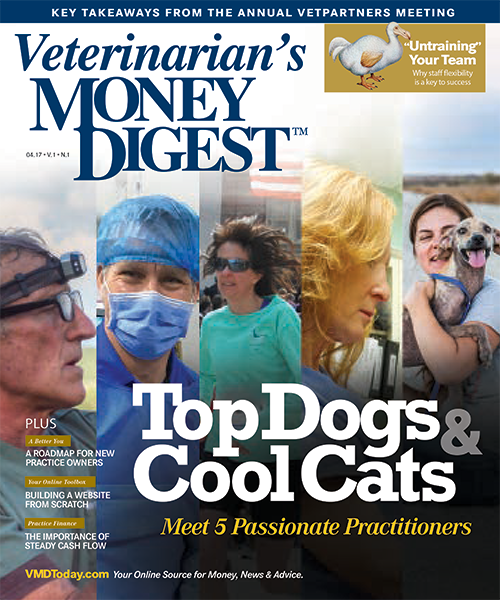Key Takeaways from the VetParters Annual Meeting
What happened at the annual VetPartners meeting that was held in March in Las Vegas, Nevada?

The veterinary practice of the future looks to utilize more technology, be less autocratic, expand beyond the traditional brick-and-mortar foundation, and offer a wider array of informational and educational services. That’s according to the eye-opening presentations at the annual VetPartners meeting held in March in Las Vegas, Nevada.
VetPartners, the nonprofit organization of veterinary business specialists, brings together experts and thought leaders twice a year, allowing members to stay up-to-date on trends, ideas and promising new tools to help veterinarians run profitable and satisfying practices.
Meeting Customer Expectations
Adam Little, DVM, director of innovation and entrepreneurship at Texas A&M University College of Veterinary Medicine & Biomedical Sciences, led a cadre of speakers on the theme. Veterinarians, by their training, equate failure with poor outcomes or death, he reminded us. In business, we need to think differently.
Veterinarians are understandably hesitant to invest heavily in new technology and ideas, but Dr. Little urged the audience to think differently about changes that pet owners already embrace. We’ve become familiar with Dr. Google, email communications, and less stressful service — as demonstrated by the 7,000 veterinary professionals who registered for Fear Free certification within the past year.
Customers expect their service providers to use the same tools they use, Dr. Little said. The electronification of medical data makes telemedicine a reality that we shouldn’t fear. In fact, many of us already use it when asking clients to take a video of a sporadically limping pet or an undesirable behavior scenario and, Dr. Little noted, regulations follow innovation. So, the more we start to embrace telemedicine, the less we will need to be concerned about violating veterinarian—client–patient relationship parameters.
In-home monitoring devices will only continue to proliferate, and unless veterinarians are open to using them and reviewing them, these devices will suffer without veterinary input. He agreed that the big issue of how to charge for a professional’s time without an office visit remains unsolved but stressed the importance of trying out different payment options to see what works best. A panel discussion on telemedicine included practitioners who have successfully done just that.

Expanding on the theme, Caleb Frankel, VMD, and Aaron Massecar, PhD, spoke about bringing the principles of lean start-up companies to veterinary practices. Meaningful change doesn’t have to be expensive or huge, Dr. Frankel argued. Successful start-ups develop quick, measurable experiments to determine if an idea deserves more investment. The most challenging part of the process is correctly identifying a problem area, as frontline staff members often have a hard time articulating specific items for action. Ambiguity, they both reminded us, leads to inaction, which develops into frustration and paralysis.
The best advice is to ask a small group of clients and staff what bothers them, pick something that affects both, and design and implement the best simple solutions garnered from your survey. Still sounds overwhelming? Dr. Massecar advocates the “build-measure-learn” approach to new things. Always make sure you have some way to measure your results. Then, whatever the outcome, share the learnings of the team with everyone.
Also consider the practice of “tiny habits.” If you want to make a change that’s big, start with a little piece. By doing so, you overcome the mental roadblock of committing to a monumental task. Another tip is to “stack” habits. Just add a new one on top of already ingrained habits. And, finally, celebrate your success. If you are trying to change things up and improve your practice, every experiment toward that end deserves some congratulations.
Progressive Practice Management
Thinking about the way practices are run continues to be a hot topic. Robert Trimble, DVM, head of veterinary services at California-based Fuzzy, reminded us of the cost of employee disengagement. With a growing need to have pet owners be our social media promoters, it’s crucial that staff feel appreciated and involved.
Dr. Trimble cited research showing that employees feel drained every day — 33 percent don’t believe in their company’s core values, 57 percent wouldn’t recommend their workplace to others, and 60 percent said their job took a toll on their personal life. Disengagement comes at a cost, and it’s time we stopped thinking about old-fashioned scientific efficiency forms of management and branched out into more inclusive and empowering forms.
Thriving In the 21st Century
According to the World Economic Forum, we are entering the Fourth Industrial Revolution and rapidly moving toward extreme digitalization. More ways to interact electronically, Generation Z, the use of robots and artificial intelligence in both manual and interpretive tasks, and the rapid interconnectedness of digital devices all point to a brand new world. VetPartners spent the time and effort to make sure its members are ready to help their veterinary clients adopt the strategies needed to thrive in the 21st century.
